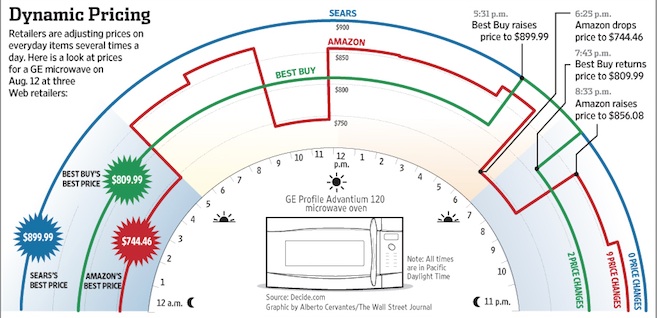On a stretch of a Dallas toll road you could have paid 91 cents, $4.48 or somewhere in between.

Used to reduce congestion, variable prices encourage drivers to select alternate routes, different departure times and other forms of transportation.
Where are we going? To how prices nudge us.
Amazon’s Dynamic Pricing
During the holidays, Amazon could be changing prices billions of times.
In the following graphic, you can see how price fluctuated for a GE microwave from 12 am to 12 pm on August 12, 2012. Although the graphic is three years old, a recent Forbes article indicates its message remains accurate.

But it gets even more interesting.
BusinessInsider tells us that Amazon continually lowers the prices of goods that are most popular. Shoppers see rockbottom bargains, buy them and then remain. Continuing to browse, they move onward to other items for which they have not done comparison shopping. Because the first deal convinced them that everything else would be cheap, they become less price aware and Amazon knows it. They were manipulating our price perception.
The Indianapolis Zoo
To visit the Indianapolis Zoo, it could cost you from $8 to $30. It all depends on the weather, group sales, the day, the season and maybe the animals? On a cold afternoon in February, the zoo is cheap. But when group sales skyrocket, the tickets they subsequently sell for that day are more expensive.
Our Bottom Line: The Power of Prices
While market determined prices have always conveyed information, the process has changed. Before the 1870s, like the Dallas toll road, Amazon and the Indianapolis Zoo, a different price for each customer had been the norm. Trained to haggle, clerks knew what was high, what was low and what would generate a profit. But then we had the invention of the 19th century department store. Think New York’s Macy’s. It would have been impossible and impractical to train hundreds of employees to negotiate a price for thousands of items.
The result? The price tag.
With single prices, customer service could blossom as would customer loyalty. We could also have price wars, money-back guarantees, pricing economies of scale, loss leaders and promotional pricing, Today’s auto dealers tell us that fixed prices for cars cut buying time by 82 percent from more than four hours to 45 minutes.
Now we are (sort of) back to where we started. Varying from customer to customer, the power of the price is individualized.






Interesting history .